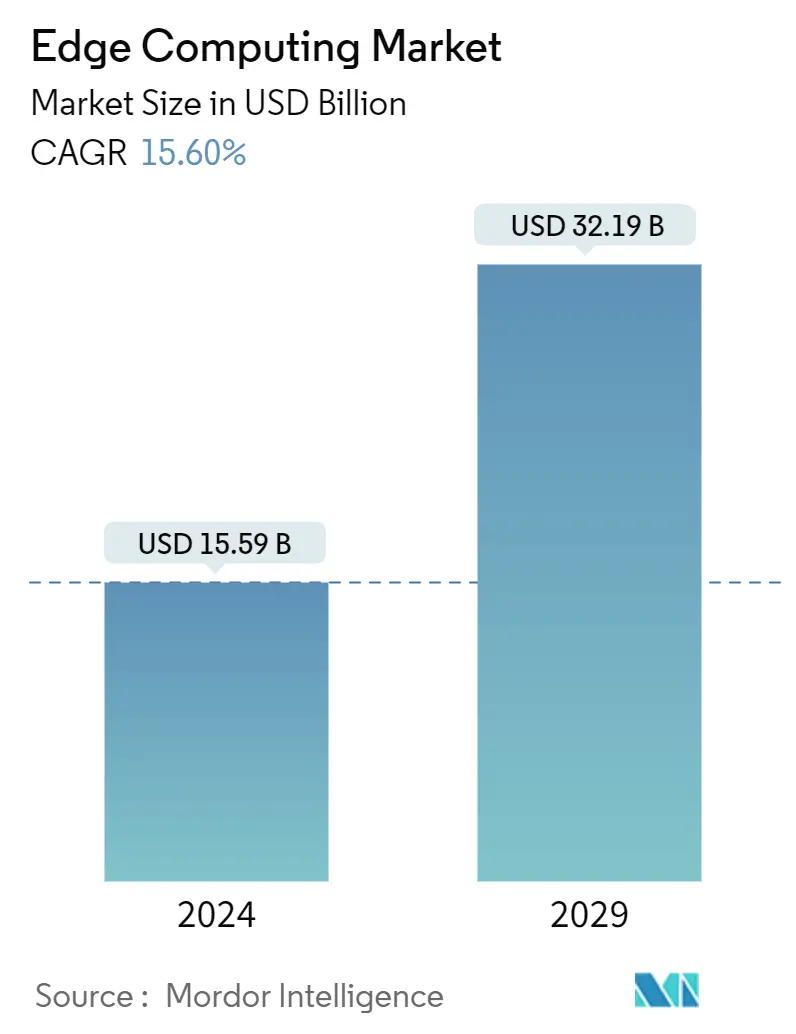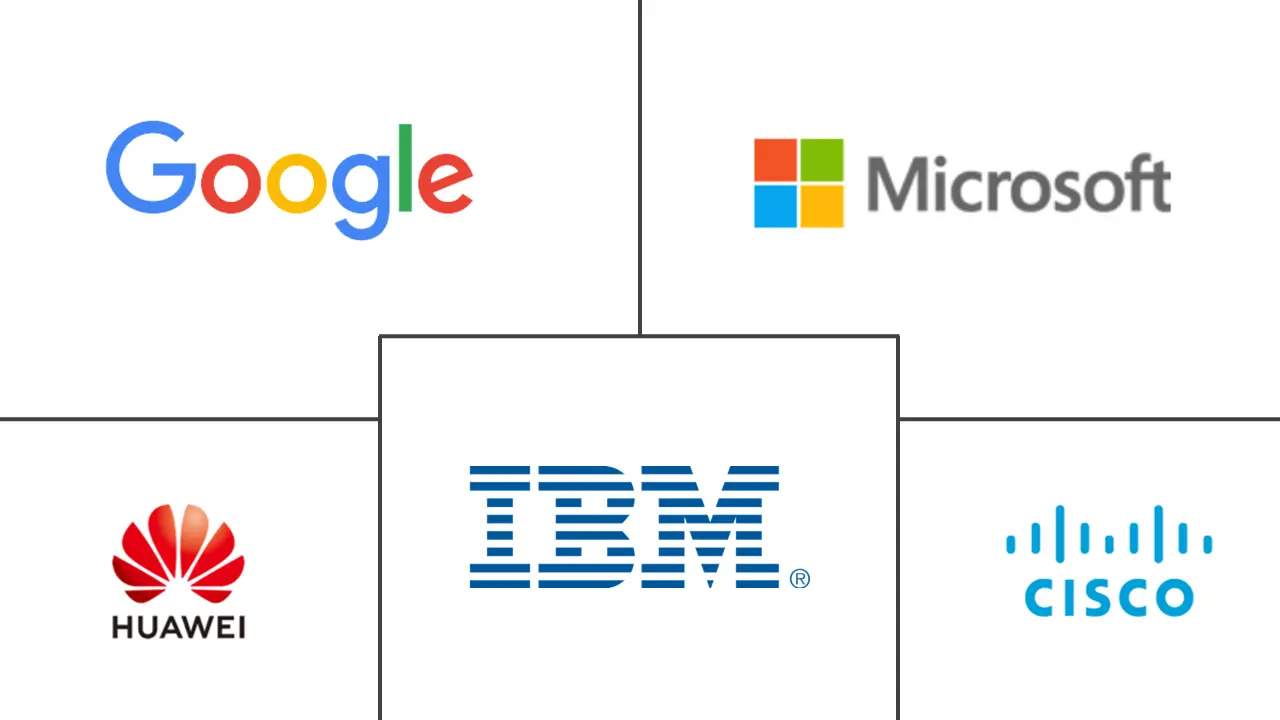Market Size of Edge Computing Industry

| Study Period | 2019 - 2029 |
| Market Size (2024) | USD 15.59 Billion |
| Market Size (2029) | USD 32.19 Billion |
| CAGR (2024 - 2029) | 15.60 % |
| Fastest Growing Market | Asia Pacific |
| Largest Market | North America |
Major Players
*Disclaimer: Major Players sorted in no particular order |
Edge Computing Market Analysis
The Edge Computing Market size is estimated at USD 15.59 billion in 2024, and is expected to reach USD 32.19 billion by 2029, growing at a CAGR of 15.60% during the forecast period (2024-2029).
The increasing adoption of IoT is augmented by 5G operations, primarily driving the growth of the market studied. A significant share of industrial IoT service providers and aggregators are offering 5G capable network offerings that are expected to adopt edge computing over the coming years for handling the sheer amount of data.
- The key players that are significantly active in the market studied include cisco, HPE, Dell, and Huawei. They have been developing edge computing products that adapt to harsh working conditions and operating environments at industrial sites, such as anti-electromagnetic interference, anti-dust, anti-explosion, anti-vibration, and anti-current/voltage fluctuations. These companies are making significant efforts in the edge computing market to create the next big thing by engaging in partnerships and making frequent product developments.
- Edge computing is being led by initiatives like OpenFog Consortium, an organization headed by vendors in the market studied, including Cisco, Intel, Microsoft, and Dell EMC, as well as academic institutions like Princeton University and Purdue University. The consortium aims at developing reference architectures for fog and edge computing deployments.
- In January 2022, Verizon and AWS partnered to expand to 30% more metro area locations in the United States with mobile edge computing with the addition of Charlotte, Detroit, Los Angeles, and Minneapolis. The combination minimizes the latency and network hops required to connect from an application hosted on the platform to the end user's device.
- The edge computing market is dominated by major vendors that cover a significant share of the market studied, and they are intensely competing to gain a foothold in different regional markets. Owing to this, vendors are involved in several partnerships and alliances to gain market presence and technological capabilities.
- For instance, In April 2022, Ball extended its agreement with AWS. This collaboration aims to launch the first public multi-access edge computing (MEC) with AWS Wavelength in Canada. 5G network is expected to bring new growth opportunities to the edge computing market.
- The COVID-19 pandemic positively affects the 5G and multi-access edge computing (MEC) deployments as businesses strategize service speed and low latency as key differentiators. The tight integration of network and compute to support next-generation apps is the way forward.
Edge Computing Industry Segmentation
Edge computing refers to the distributed computing paradigm, mainly used to bring computing and data storage closer to the location to improve the response time. The analysis tools used across industries are beginning to drive new levels of performance and productivity. Therefore, the distributed computing paradigm called edge computing is gaining traction.
The Edge Computing Market is Segmented by Component (Hardware, Software, and Services), End User (Financial and Banking Industry, Retail, Healthcare and Life Sciences, Industrial, Energy and Utilities, Telecommunications), and Geography (North America, Europe, Asia Pacific, Latin America, Middle East & Africa).
The market sizes and forecasts are provided in terms of value (USD Billion) for all the above segments.
| By Component | |
| Hardware | |
| Software | |
| Services |
| By End-user | |
| Financial and Banking Industry | |
| Retail | |
| Healthcare and Life Sciences | |
| Industrial | |
| Energy and Utilities | |
| Telecommunications | |
| Other End-users |
| By Geography | ||||||
| ||||||
| ||||||
| ||||||
| ||||||
|
Edge Computing Market Size Summary
The edge computing market is experiencing significant growth, driven by the increasing adoption of IoT and the expansion of 5G networks. This growth is primarily fueled by the need to manage vast amounts of data generated by these technologies. Major players in the industry, such as Cisco, HPE, Dell, and Huawei, are actively developing edge computing solutions that can withstand challenging industrial environments. These companies are also engaging in strategic partnerships and product innovations to strengthen their market position. Initiatives like the OpenFog Consortium, which includes key industry vendors and academic institutions, are working towards establishing reference architectures for edge computing deployments. The collaboration between Verizon and AWS to expand mobile edge computing in the United States exemplifies the industry's efforts to reduce latency and enhance connectivity.
In the telecommunications sector, edge computing is poised to transform networks by leveraging the capabilities of 5G and IoT. Telecom operators are investing in edge computing to improve core connectivity, reduce latency, and introduce new services. The demand for edge computing is further accelerated by the proliferation of 5G-compliant devices, which necessitate additional computing resources at the edge. In regions like China, edge computing is being integrated with surveillance technology, catering to the growing demand for smart solutions. Similarly, in India, initiatives like the Digital India program and collaborations between companies such as Reliance Jio and Tata Consultancy Services are driving the adoption of edge computing. The market remains competitive, with cloud-based IoT vendors and companies with industry-specific expertise employing strategies like acquisitions and partnerships to enhance their offerings.
Edge Computing Market Size - Table of Contents
-
1. MARKET INSIGHTS
-
1.1 Market Overview
-
1.2 Industry Attractiveness - Porter's Five Forces Analysis
-
1.2.1 Bargaining Power of Suppliers
-
1.2.2 Bargaining Power of Buyers
-
1.2.3 Threat of New Entrants
-
1.2.4 Threat of Substitutes
-
1.2.5 Intensity of Competitive Rivalry
-
-
1.3 Industry Value Chain Analysis
-
1.4 Assessment of the Impact of COVID-19 on the Market
-
-
2. MARKET SEGMENTATION
-
2.1 By Component
-
2.1.1 Hardware
-
2.1.2 Software
-
2.1.3 Services
-
-
2.2 By End-user
-
2.2.1 Financial and Banking Industry
-
2.2.2 Retail
-
2.2.3 Healthcare and Life Sciences
-
2.2.4 Industrial
-
2.2.5 Energy and Utilities
-
2.2.6 Telecommunications
-
2.2.7 Other End-users
-
-
2.3 By Geography
-
2.3.1 North America
-
2.3.1.1 United States
-
2.3.1.2 Canada
-
-
2.3.2 Europe
-
2.3.2.1 United Kingdom
-
2.3.2.2 Germany
-
2.3.2.3 France
-
2.3.2.4 Rest of Europe
-
-
2.3.3 Asia Pacific
-
2.3.3.1 China
-
2.3.3.2 Japan
-
2.3.3.3 Australia
-
2.3.3.4 Rest of Asia Pacific
-
-
2.3.4 Latin America
-
2.3.4.1 Mexico
-
2.3.4.2 Brazil
-
2.3.4.3 Rest of Latin America
-
-
2.3.5 Middle East and Africa
-
2.3.5.1 United Arab Emirates
-
2.3.5.2 Saudi Arabia
-
2.3.5.3 Rest of Middle East and Africa
-
-
-
Edge Computing Market Size FAQs
How big is the Edge Computing Market?
The Edge Computing Market size is expected to reach USD 15.59 billion in 2024 and grow at a CAGR of 15.60% to reach USD 32.19 billion by 2029.
What is the current Edge Computing Market size?
In 2024, the Edge Computing Market size is expected to reach USD 15.59 billion.

